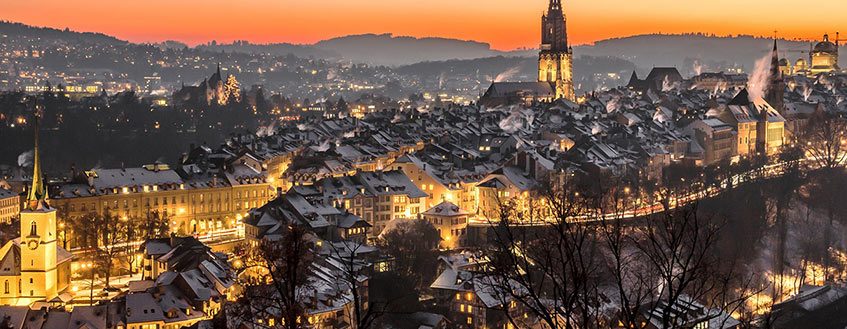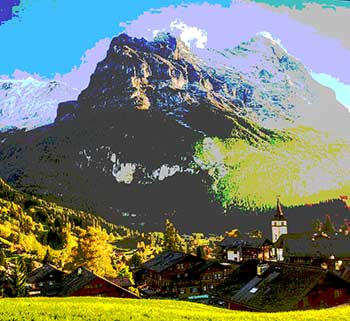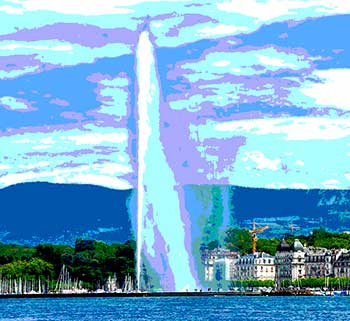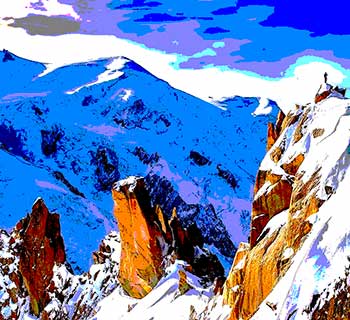Things to do in Bern, SWITZERLAND
Bern, the capital of Switzerland, is a beautiful and tranquil city full of museums, churches and historic buildings.
Established in the 12th century, and named after a bear found in a nearby forest, Bern's most important building is the imposing Federal Palace. Open to the public when Parliament is not sitting, this domed structure is full of stained glass windows and statues.
Visitors must also take in Bern's world heritage status Old Town, with its cobbled streets, arcades and fountains, and cross the turquoise River Aare to see four bears in Bern's Bear Park (Barenpark).
Those looking for culture will find it in Bern's Fine Arts Museum (Kunstmuseum), the Historical Museum of Bern, the Albert Einstein Museum (dedicated to Bern's most famous resident), the Paul Klee Centre, and the Natural History Museum.
Other must-see attractions are Bern's Cathedral (Bernmunster), complete with 330-foot bell tower and high-quality carvings, and Bern's Rose Garden (Rosengarten). Bern also offers top hotels, high-class cuisine and shopping, and a number of famous festivals, such as the Gurtenfestival and Bern Jazz Festival.
1. Federal Palace
Built between 1894 and 1902, under the supervision of architect Hans Wilhelm Auer, the imposing Federal Palace is the national parliament of Switzerland.
The building is crowned by an imposing 64 metre-high green dome, decorated with stained glass windows depicting the coats of arms of Switzerland's cantons and a central mosaic of the Federal coat of arms with the motto ‘One for all and all for one’.
Underneath the dome is found the Bundeshaus' central hall, separating the two legislative chambers (the National Council and Council of States). Don't miss the hall's stained-glass windows illustrating Switzerland’s four regions and their main economic activities.
Another must-see is the huge statue of the three confederates, Uri, Schwyz and Unterwalden, the founders of modern Switzerland (who in 1291 swore the confederation oath on the Rutli meadow).
The National Council is the larger of Switzerland's legislative chambers, with 200 members elected under a system of proportional representation (with one representative for each 40,000 or so voters). Its chamber is dominated by a large fresco by Giron representing the Confederation’s cradle.
With 46 members, the Council of States is much smaller (most cantons are permitted to send two representatives); its chamber is decorated with a large Albert Welto mural depicting a people’s assembly in the Nidwalden canton. MAP
After each election, the members of the two chambers merge to form the Federal Assembly, responsible for electing the executive (called the Federal Council) and appointing Supreme Court judges. The Federal Council comprises seven members, from whom the Federal Chancellor (the Swiss head of state) is elected.
The adjacent newly renovated Parliament Square (Bundesplatz) is paved with granite slabs from the Alps and contains 26 hidden water-jets (one for each canton).
German, French, Italian and English language tours lasting 60 minutes are available when Parliament is in recess.
Top Tip ...
Be sure to book up to 3 days in advance: tours are limited to 40 people and only available at specific times of the week. Visitors will need to bring official ID (passports are safest). Tourists can also access the building to watch debates when Parliament is in session; but again spaces are very restricted.
2. Bern's Bear Park (Barenpark)
Bern (or Berne) was founded by Duke Berthold V of Zähringen in 1191.
Legend has it that the Duke named Bern after a bear he encountered whilst hunting in the surrounding forest (one of the German words for 'bear' is 'bären'). (Another less romantic theory is that Bern was named after Verona, the word for which was Bern in Middle High German.)
By 1220 the bear had made its way onto Bern's coat of arms, and in 1513 the Bernese returned victorious from the Battle of Novara carrying a bear. The bear had, therefore, become synonymous with Bern.
Bern's first Bear Park (aka the Bear Pit, Bärenpark or Bärengraben) opened in 1857. Found at the far end of the Nydeggbrucke bridge, next to the River Aare, the original bear pit is listed as an object of national cultural significance.
Today, the bear pit and 6,000 square metres of interconnected enclosures house four brown bears: Byörk and Finn and their two cubs, born in December 2009, Ursina and Berna. They are often to be found play-fighting in their grassy enclosure, swimming in the 'bear bath', or eating apples, melons or other vegetarian fare.
The new complex, opened in 2009, cost CHF24 million (twice the initial budget). But there was no complaint from the 40,000 locals who turned up to watch the opening ceremony.
where? Bear Park (Bärenpark), Grosser Muristalden 6, 3006, Old Town, Bern. MAP
when? Daily, 8am to 5pm.
£$€¥ Free.
3. Einstein Museum and Historical Museum of Bern
The Historical Museum of Bern (aka Historiches Museum Bern and Musée d'Histoire de Berne), incorporating the Einstein Museum, is the second largest museum in Switzerland.
Housed in an imposing 1894 Andre Lambert designed building, based on historic castles from the 15th and 16th centuries, the Museum is found on the Helvetiaplatz (a short walk across the River Aare from the Old Town).
The Historical Museum
The Historical Museum's permanent collection displays 500,000 objects dating from the Stone Age, arranged into eight galleries such as ‘Stone Age, Celts and Romans', 'From the Middle Ages to the Ancien Regime', ‘Bern’s Silver Treasure’, ‘Captured Treasure—Court Art in Bern’ and ‘Bern and the 20th Century’.
Highlights include objects from the burial site of a Bronze Age leader from nearby Thun, Flemish tapestries from the 15th century, a Königsfelden diptych painted for the King of Hungary, a Bodhisattva Buddha from South Asia, a Japanese Daimyo suit of armour and a Hawaiian feather cloak collected by Captain Cook.
The Museum's current temporary exhibition (until June 2020) is Homo Migrans, covering a long period in our history, beginning with the first human beings in Africa, then charting their gradual spread across the globe two million years ago and culminating in a look at Switzerland today.
The Einstein Museum
The Einstein Museum is devoted to the life of the world's most famous modern scientist. Einstein (1879-1955) lived in Bern between 1903 and 1909, working as a patent office clerk and then as a lecturer at the University of Bern; it was during this period that Einstein published his 1905 Annus Mirabilis papers on photoelectric effect, Brownian motion, the special theory of relativity and E=mc2.
The Museum traces the different aspects of Einstein's life in 1000 square metres of exhibition space. There are over 550 original objects, 70 films, and a number of animations.
Highlights include Einstein’s (very average) school reports, numerous letters sent or received by Einstein (such as a letter warning President Roosevelt of German nuclear capabilities in 1939 and a letter inviting Einstein to become the President of Israel in 1952), a gallery devoted to Einstein’s many lovers, interactive displays explaining the special and general theories of relativity, and Einstein’s 1921 Nobel prize certificate.
where? Helvetiaplatz 5, 3005 Bern. T: 031 350 7711. E: info@bhm.ch. MAP
when? 10 am to 5 pm, six days a week. Closed Mondays.
£$€¥ Adults: CHF18; Children (6-16): CHF8; Concessions: CHF13 (Dec 2019).
4. The Kunstmuseum (Museum of Fine Arts)
The Kunstmuseum (aka the Museum of Fine Arts) holds over 4,000 paintings in its permanent collection and is Switzerland’s oldest and premier fine arts gallery.
Housed in the late 19th century Stettler building in the northern part of Bern’s old town, the Kunstmuseum’s works range from the Gothic era to the present day. In addition to its paintings, the museum houses almost 50,000 drawings, prints, photos and films.
Works by many of the world’s top artists are on display, such as
- Ferdinand Holder’s The Consecrated One and Jungfrau and Silverhorn, as Seen from Murren,
- Pablo Picasso’s The Sleepy Drinker, from his blue period, together with a number of works from his cubism days,
- Claude Monet’s Ice Drift,
- Vincent van Gogh’s Head of a Peasant Woman with White Cap and Still Life with Two Sunflowers (pictured),
- Edouard Manet's Garden Walk at Reuil, a fairly rare landscape painted by Manet in the last year of his life,
- Alfred Sisley’s Langland Bay,
- Paul Gaugin's When Will You Marry?,
- one of Paul Cezanne's self portraits (pictured), and
- Amedeo Modigliani’s Portrait of Pinchus Kremenge.
The Kunstmuseum runs two or three temporary exhibitions alongside its permanent collection, usually with a contemporary theme, and has an excellent café/bar. It is regarded as the country's best fine arts museum, closely followed by Zurich's Kunsthaus.
Recent temporary exhibitions have included Liechtenstein: the Princely Collection and Masterpieces of the Collection (celebrating the re-hanging of the Kunstmuseum's most important works). The Kunstmuseum's current exhibition is called Johannes Itten: Art as life (Bauhaus utopias and documents of reality) (till February 2020).
where? Kunstmuseum, Hodlerstrasse 8-12, 3000 Bern 7. T 031 328 09 44. E info@kunstmuseumbern.ch. MAP
when? 10 am to 5 pm, six days a week. Late opening on Tues until 9 pm. Closed Mondays.
£$€¥ Adults: CHF10; Children (6-16): Free; Concessions: CHF7 (Dec 19).


































